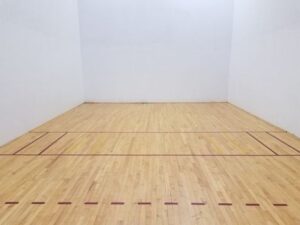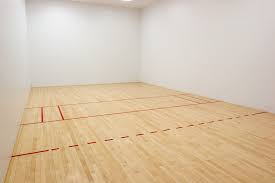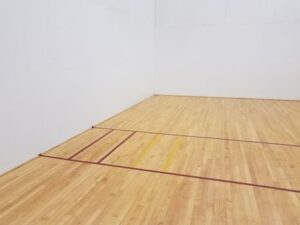There are multiple red lines on a racquetball court. Some of the lines run horizontally across the court from Side wall to side wall and others run vertically in a direction from the back wall toward the front wall of the court. Most of the lines are solid but one is dashed or forms a broken, dashed line. Each of the lines has a very important and specific function. Some are to even the playing field and perform to help keep one player from deceiving the other(s). Some of the lines are specific to fair game play and others are for player safety.

What is the size of a Racquetball Court?
The court measures 20 feet wide from side wall to side wall and 40 feet long from the front wall to the back wall. The court is also 20 feet tall to the ceiling.

What are the Horizontal Red Lines in a Racquetball Court?
The horizontal lines painted on a racquetball court floor run from side wall to side wall.
The Service Line
The first red line seen when moving from the front wall to the rear wall is called the “Service Line”. The service line is 15 feet from the front wall.
The purpose of this line is to keep play fair. The service line functions as the furthest place forward a player can go when serving the ball. It is also the furthest point forward the server can bounce the ball during a serve.
What is interesting about this line is that the server can step on the line and part their foot can even touch forward of this line as long as their entire foot does not cross it.
If the entire foot of the server crosses this line while serving, it is a foot fault and the server has to re-serve (2nd serve) or side out if it was already the server’s second serve.
The Short Line
The second red line seen when moving from the front wall to the rear wall is called the “Short Line”. The short line splits the court in half at 20 feet from the front and back wall.
The purpose of this line is to keep play fair. The service line functions as an indicator depicting the edge of where a ball can first contact the floor during a serve.
The ball must fully clear this line during a serve. If the ball bounces on the line or before the line, it is considered a short serve and the server has to re-serve (2nd serve) or side out if it was already the server’s second serve.
This is one of the most contested calls on the court. The ball moves very fast, especially during a drive serve and it is sometimes difficult to know 100% if the ball cleared this line or barely bounced on it.
The Receiving Line
The third red line seen when moving from the front wall to the rear wall is called the “Receiving Line” or the “Encroachment Line”. The service line is a broken or dashed line extending from one side wall to the other.
The receiving line is 25 feet from the front wall and 15 feet from the back wall. The purpose of this line is for player safety.
The receiving line functions to create a safety zone between the server and the returner. The returner cannot cross this line and enter the safety zone with the racquet or any part of their body until the ball bounces within the zone. Also, the returner cannot hit a ball in flight until it crosses outside the safety zone and beyond the receiving line.
The penalty for entering the safety area before the ball bounces or for any part of the returner’s body or racquet going past the receiving line is a loss of rally and subsequently, a point. Play stops immediately for safety reasons.
What are the Lateral Red Lines in a Racquetball Court?
There are 4 lines that run front to back but they do not run the entire length of the court.
These 2 lines on the left side of the court are mirror images of 2 lines on the right side of the court and are contained within the service area. They exist only in the 5 feet between the service line and the short line.

The Partner Service Box
The first set of lines is 18 inches from the side walls. These are called partner service boxes.
These are used in the course of a doubles game. The partner of the person serving must stay in this box with their back against the wall.
If the served ball hits them directly off the front wall, and the person in the partner service box has not moved from the service box, the server gets a second attempt. If the partner is hit while moving from within the partner service box, the point is lost and it goes to the second server or side out.
The 3-Foot Lines
The second innermost vertical lines on the racquetball court are called the 3-foot lines. These lines as they indicate are 3 feet in from the side walls on both sides of the court and also contained in the service area. These lines come into play only during a serve. The servers’ racquet or person cannot cross this 3-foot line and continue to drive serve straight down the same side of the court. If so, it is very possible the ball would pass very close to the server’s body and create a visual hinder situation for the returner.

Here is a list and brief description of the lines on a racquetball court:
The ‘Short Line’ divides the court in half at 20’
The ‘Service Line’ is 5’ in front of the Short Lin
The ‘Receiving Line’ is the broken line that runs parallel to and is 5’ behind the Short Line. It is also known as the ‘Encroachment Line’
The area between the Receiving (Encroachment) Line and the Short Line is called the ‘Safety Zone’
The 2 boxes on the sides of the court used during doubles play are the ‘Service Boxes’. They extend 18” inward from the walls
The 2 lines inside the service boxes are called the ‘3-foot lines’. They are 3 feet from the left and right walls and indicate how far away from the side wall the server has to be during a drive serve
**By the way, there are no out-of-bounds in a racquetball court. There are rules to adhere to that fall within the perimeters of the game but all walls and surfaces are in play. This includes the ceiling of the court.


Write more, thats all I have to say. Literally, it seems as though you relied on the video to make your point. You obviously know what youre talking about, why throw away your intelligence on just posting videos to your weblog when you could be giving us something informative to read?
Thanks for this information. I was looking for a description of how the line 12 feet up on the back line is used. I thought it was a point or side out if the ball ever hit above that line. Either on the fly or bouncing.
child porn
I rattling pleased to find this site on bing, just what I was looking for : D likewise saved to fav.
Magnificent site. A lot of useful information here. I’m sending it to several friends ans also sharing in delicious. And of course, thank you for your sweat!
This is a topic close to my heart cheers, where are your contact details though?
Hey there, You have done an incredible job. I will definitely digg it and personally suggest to my friends. I am sure they’ll be benefited from this web site.
Hello! I just would like to give a huge thumbs up for the great info you have here on this post. I will be coming back to your blog for more soon.
I keep listening to the newscast lecture about receiving free online grant applications so I have been looking around for the best site to get one. Could you advise me please, where could i acquire some?
As I site possessor I believe the content material here is rattling fantastic , appreciate it for your efforts. You should keep it up forever! Good Luck.
I have recently started a blog, the information you provide on this web site has helped me tremendously. Thank you for all of your time & work. “Yield not to evils, but attack all the more boldly.” by Virgil.
I just could not go away your web site prior to suggesting that I extremely loved the standard information a person provide for your guests? Is gonna be again frequently in order to check up on new posts.
Yay google is my king aided me to find this outstanding web site! .
tipobet porn
child porn
Nice post. I was checking continuously this blog and I’m impressed! Very useful info specifically the last part 🙂 I care for such information a lot. I was looking for this certain info for a long time. Thank you and best of luck.
Absolutely indited articles, Really enjoyed examining.
I’d constantly want to be update on new blog posts on this website , saved to fav! .
Thanks, I’ve just been searching for information about this topic for a long time and yours is the best I have came upon so far. But, what in regards to the bottom line? Are you positive in regards to the supply?
I’d constantly want to be update on new posts on this site, saved to favorites! .
I love your blog.. very nice colors & theme. Did you create this website yourself? Plz reply back as I’m looking to create my own blog and would like to know wheere u got this from. thanks
I really appreciate this post. I’ve been looking all over for this! Thank goodness I found it on Bing. You’ve made my day! Thanks again!
I found your blog website on google and verify a couple of of your early posts. Continue to keep up the superb operate. I simply further up your RSS feed to my MSN Information Reader. In search of forward to reading extra from you in a while!…
Wonderful web site. A lot of useful information here. I’m sending it to a few friends ans also sharing in delicious. And certainly, thanks for your sweat!
You have remarked very interesting points! ps decent website .
Wow! Thank you! I continually wanted to write on my site something like that. Can I implement a part of your post to my website?
Only a smiling visitor here to share the love (:, btw outstanding design. “Make the most of your regrets… . To regret deeply is to live afresh.” by Henry David Thoreau.
you’re really a good webmaster. The web site loading speed is incredible. It seems that you are doing any unique trick. In addition, The contents are masterwork. you’ve done a magnificent job on this topic!
magnificent post, very informative. I wonder why the other specialists of this sector don’t notice this. You should continue your writing. I’m confident, you have a huge readers’ base already!
tipobot porn
I really enjoy examining on this internet site, it has fantastic content.
Hey just wanted to give you a quick heads up and let you know a few of the images aren’t loading correctly. I’m not sure why but I think its a linking issue. I’ve tried it in two different internet browsers and both show the same outcome.
Can you be more specific about the content of your article? After reading it, I still have some doubts. Hope you can help me.
Can you be more specific about the content of your article? After reading it, I still have some doubts. Hope you can help me.
Your point of view caught my eye and was very interesting. Thanks. I have a question for you.
Great post. I was checking continuously this weblog and I am impressed! Very helpful information particularly the closing section 🙂 I deal with such info a lot. I was looking for this particular info for a long time. Thank you and best of luck.
Your point of view caught my eye and was very interesting. Thanks. I have a question for you.
I was just seeking this information for a while. After six hours of continuous Googleing, at last I got it in your site. I wonder what’s the lack of Google strategy that do not rank this kind of informative websites in top of the list. Usually the top websites are full of garbage.
I have been absent for some time, but now I remember why I used to love this blog. Thanks, I’ll try and check back more frequently. How frequently you update your web site?
Regards for helping out, great information.
Thank you so much for sharing this wonderful post with us.
Good info. Lucky me I reach on your website by accident, I bookmarked it.
Thank you for your sharing. I am worried that I lack creative ideas. It is your article that makes me full of hope. Thank you. But, I have a question, can you help me?
An interesting dialogue is price comment. I think that you must write more on this topic, it might not be a taboo topic however usually persons are not enough to speak on such topics. To the next. Cheers
Keep working ,terrific job!
Your article helped me a lot, is there any more related content? Thanks!
My brother recommended I might like this website. He was entirely right. This post truly made my day. You cann’t imagine just how much time I had spent for this information! Thanks!
With havin so much written content do you ever run into any issues of plagorism or copyright violation? My website has a lot of exclusive content I’ve either created myself or outsourced but it seems a lot of it is popping it up all over the web without my permission. Do you know any techniques to help prevent content from being ripped off? I’d certainly appreciate it.
Esse conteúdo é de altíssima qualidade! Você faz a diferença com esse conteúdo! Amo ver posts assim, parabéns! Um excelente trabalho de criatividade! Seu post é uma verdadeira inspiração! 🙏🏾 https://kurier.today/
Thank you for your sharing. I am worried that I lack creative ideas. It is your article that makes me full of hope. Thank you. But, I have a question, can you help me?
I don’t think the title of your article matches the content lol. Just kidding, mainly because I had some doubts after reading the article.
Your article helped me a lot, is there any more related content? Thanks!
Thank you for your sharing. I am worried that I lack creative ideas. It is your article that makes me full of hope. Thank you. But, I have a question, can you help me?
I am no longer certain the place you are getting your info, but great topic. I must spend a while studying more or understanding more. Thanks for excellent info I was on the lookout for this information for my mission.
I am curious to find out what blog platform you happen to be utilizing? I’m experiencing some minor security issues with my latest site and I would like to find something more safeguarded. Do you have any solutions?